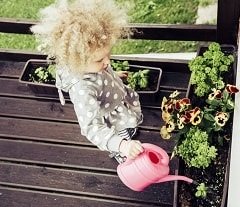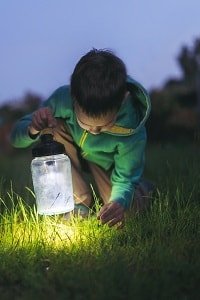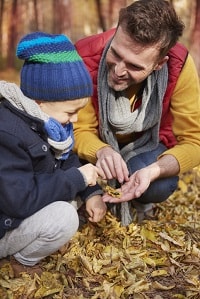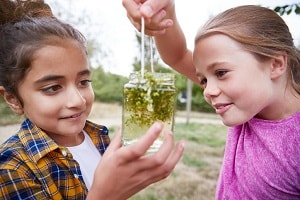How to connect with nature: Tips for tuning into the natural world
© 2022 GWEN DEWAR, PH.D., ALL RIGHTS RESERVED
 opens IMAGE file
opens IMAGE file
People who connect with nature are happier, and children who connect with nature are more than prosocial and meliorate-behaved. How can we help our families feel a greater sense of connexion?
You already know that kids benefit opens in a new windowwhen they play outdoors. They also reap special benefits when they spend fourth dimension in nature. opens in a new windowWe all practice. And research suggests it isn't just a matter of spending fourth dimension — of existence in that location, existence physically nowadays.
- Kids who feel an emotional, psychological connection with nature tend to take fewer beliefs bug.
- They are more than "prosocial" — more than likely to prove sympathy for others, more probable to offer a helping mitt.
- And, like adults, children who connect with nature tend to experience a greater sense of happiness and well-existence.
Read more about information technology in my commodity, opens in a new window"Kids who feel connected with nature are happier — and better-behaved."
But here, allow's focus on the practicalities. What can we practice to assistance our families feel a greater sense of connection to nature?
How to connect with nature: xi tips
i. Got a young child? Start now.
The evidence is pretty consistent. Adults who experience strongly connected with nature are more likely to accept experienced lots of contact with nature as children. And enquiry suggests that kids discover information technology easier to forge a connexion with nature when they are younger — i.e., before the age of 10 or eleven (Bruni and Schultz 2010; Leiflander et al 2013).
2. Don't wait effectually for the perfect trip to the Great Outdoors. Find opportunities for everyday nature encounters, however apprehensive.

If yous live in the city — or lack access to a private backyard or garden — you might feel that "visiting nature" means traveling to a major attraction. But should yous wait around until you have the opportunity to make such trips?
No. Frequent contact with nature is important, and research confirms that kids can form strong connections with nature even if they alive in high-rise apartment buildings (Sobko et al 2018).
So information technology doesn't make sense to wait until you can plan the perfect trip to a special dazzler spot. Don't allow the perfect be the enemy of the practiced!
Visiting your neighborhood park is helpful, fifty-fifty if it offers only a grassy field, or a stand of trees. And when you can't make it to the park? Your child can benefit from monitoring a small-scale container garden.
3. Assistance your family into nature with interactive, goal-based activities — like bird feeding, bird-watching, keeping a wild fauna log, or going on a "bug safari."

To actually connect with nature, we need to pay attending to our environment. Just what if kids are slow to engage, or don't seem interested? Grab their attention with activities that require shut ascertainment — and a goal.
For example, inquiry suggests that people feel more connected with nature when they feed local birds (Cox and Gaston 2016).
Kids have go more involved after engaging in daily wild animals monitoring, similar bird-watching, and taking tallies of the different species they've spotted (White et al 2018).
In the same manner, your child might benefit from going on a "issues safari" (a quest to observe dissimilar kinds of insects), or a hunt for interesting rocks, seeds, or pine cones.
For more ideas, run into this Parenting Scientific discipline guide to opens in a new windowanimate being tracking activities for young children.
4. Teach kids how to be considerate and respectful of nature.

Existence outdoors is a great opportunity for a child to exist boisterous, and make no mistake: Kids thrive when nosotros provide them with open spaces to run around and explore.
But kids also need to learn basic guidelines for behaving with consideration, pity, and respect. Indeed, as I explain opens in a new windowelsewhere, researchers regard empathy for nature and respect for nature as essential for experiencing a stiff sense of connection to nature.
Then we should teach kids how to share spaces with other visitors and wildlife.
- Teach kids almost the harm acquired by littering and pollution.
- Teach children that trees are live; damaging them makes them more vulnerable to pests and affliction.
- Explain why information technology'due south important to stay on a marked trail — and out of environmentally-sensitive areas.
- Remind kids that animals should exist treated with respect; don't allow kids to harass them.
- Bear witness kids when and how to utilize their "placidity voice."
5. Communicate nature experiences — by writing, drawing pictures, painting, sculpting, or taking photographs.

Research suggests that nosotros experience more than deeply continued to nature when nosotros share our nature experiences with others (McEwan et al 2019). And kids may reap special benefits when they limited their ideas creatively.
For instance, in one study, kids reported more intense connections with nature after they finished a creative projection — a drawing, painting, sculpture, story, or photoessay — communicating their observations of the natural world (Bruni et al 2017).
vi. Unless you are using it to photo nature, put away your smart phone.
Folks who are really preoccupied with their cell phones – and who use their phones every bit an escape from negative feelings – are less probable to experience feelings of connectedness with nature (Richardson et al 2018).
7. Learn how to identify the local wild fauna.
City dwellers are often unaware of the biological diversity around them, and that's a barrier: People are more likely to feel connected with nature when they are familiar with the species they encounter.
For instance, in a study of people living in the U.K., researchers found that individuals had more positive responses to birds when they could identify unlike species, and something about the birds' behavior (Cox and Gaston 2015).
So don't just send kids outdoors. Provide them with opportunities to acquire almost wildlife. Wait for online guides to the biodiversity in your area. If you're in the U.Due south., wait up your local branch of the opens in a new windowAudubon society, and check out the opens in a new windowNational Wildlife Federation'southward nature guide apps.
8. Acquire how to protect local wildlife.
Getting involved with local conservation doesn't only help the environment. It can also aid the states deepen our feelings about nature. Only what sorts of things tin can we do?
- Pick up litter.
- Aid plant native trees in your community.
- If you are fortunate enough to have a private outdoor space, create a garden that is friendly to wildlife. For guidance, see these pages — with links to detailed articles — from the opens in a new windowNatural Wild animals Federation (The states) and the opens in a new windowPurple Society for the Protection of Birds (UK).
- Participate in local rescue projects — saving creatures that are under direct threat from homo-made infrastructure.
Kids can aid with each of these — even rescue projects — and the experiences are probable to boost their environmental awareness and empathy for wild fauna.

For example, in an uncomplicated schoolhouse in Sweden, 5th graders participated in an eight-calendar week projection to rescue amphibians from a man-fabricated hazard.
The students learned nigh the ecology and behavior of a local salamander species.
They also took turns searching for, and transporting, salamanders that were trapped in a dried-up, concrete wading pool.
The children's efforts helped the environment, and also had a transformative effect on the kids (Barthel et al 2018).
Immediately later on completing the projection — and in interviews conducted two years later — kids said the project made them feel more empathy and concern for the salamanders. They besides reflected that the project had helped them understand the importance of nature.
ix. Encourage kids to await at the sky, and learn about weather condition patterns.
It's not terribly surprising: Kids discover it more than difficult to connect with nature when the atmospheric condition makes them uncomfortable — or limits their activities (Talebpour et al 2020). Grandma was right. Kids actually should go outside when the weather is expert.
But at the aforementioned fourth dimension, nosotros don't need to give up on nature experiences because information technology'south rainy or windy or otherwise difficult. In fact, learning about weather patterns can exist an exciting fashion to connect with nature.
x. Going to visit a new place? Give your kid a preview first.
Going to a new beach? A absurd waterfall? A mountain trail? A scenic gorge? The Grand Coulee?
Whether it's a local beauty spot, or a major world attraction, give your kids the opportunity to look and learn earlier yous visit. Help kids learn what to expect — what'southward heady and interesting about this location. What plants and animals can you expect to find there? What geological features be, and how were they formed?
You tin can find images and information in books, merely look, too, for images and videos online. Learning in advance builds apprehension. Information technology will also make your visit more enjoyable.
xi. What if you can't get outdoors? Know that just looking out the window — or watching beautiful nature programs — can deliver benefits.

To savor the positive psychological benefits of nature, yous don't accept to exist outdoors. As I explain opens in a new windowelsewhere, researchers take shown that just looking at scenes of nature can help.
Then when y'all're stuck indoors, don't surrender on nature experiences. Expose your child to exciting nature documentaries and photographs. And if yous're lucky enough to take a window view of nature, take the time to relish it.
Bank check out these Parenting Scientific discipline articles on related subjects:
- Green spaces benefit mental health (an in-depth look at the evidence)
- 12 benefits of outdoor play (includes practical takeaways for making the most of your child's time outside)
- Outdoor learning and green fourth dimension (explains how kids benefit from learning and playing in nature)
References: How to connect with nature
Barrable A and Booth D. 2020. Increasing Nature Connection in Children: A Mini Review of Interventions. Front Psychol. xi:492.
Barrera-Hernández LF, Sotelo-Castillo MA, Echeverría-Castro SB, Tapia-Fonllem CO. 2020. Connection to Nature: Its Bear upon on Sustainable Behaviors and Happiness in Children. Front Psychol. 11:276.
Barthel Due south, Belton S, Raymond CM, Giusti K. 2018. Fostering Children's Connexion to Nature Through Authentic Situations: The Case of Saving Salamanders at School. Front Psychol. ix:928.
Brom P, Anderson P, Channing A, Underhill LG. 2020. The role of cultural norms in shaping attitudes towards amphibians in Greatcoat Town, South Africa. PLoS Ane. fifteen(ii):e0219331.
Bruni CM and Schultz Pow. 2010. Implicit behavior about self and nature: Evidence from an IAT game.Journal of Environmental Psychology 30(1): 95-102.
Bruni CM, Wintertime PL, Schultz PW, Omoto AM and Tabanico JJ. 2017. Getting to know nature: evaluating the effects of the Go to Know Program on children's connectedness with nature. Environmental Pedagogy Research, 23(one), 43–62.
Capaldi CA, Dopko RL, Zelenski JM. 2014. The relationship betwixt nature connection and happiness: a meta-assay. Front Psychol. five:976.
Ceríaco LM. 2012. Homo attitudes towards herpetofauna: the influence of folklore and negative values on the conservation of amphibians and reptiles in Portugal. J Ethnobiol Ethnomed. 8:8.
Cox DT and Gaston KJ. 2016. Urban Bird Feeding: Connecting People with Nature. PLoS One. 11(7):e0158717.
Cox DT and Gaston KJ. 2015. Likeability of garden birds: Importance of species knowledge and richness in connecting people to nature. PLoS One. 10(11):e0141505.
Duron-Ramos MF, Collado Southward, García-Vázquez FI, Bello-Echeverria M. 2020. The Role of Urban/Rural Environments on Mexican Children's Connection to Nature and Pro-environmental Beliefs. Forepart Psychol. 2020;11:514.
Joye Y and Bolderdijk JW. 2015. An exploratory study into the furnishings of extraordinary nature on emotions, mood, and prosociality. Front Psychol. 5:1577.
Liefländer AK, Gabriele Fröhlich, Franz Ten. Bogner & P. Wesley Schultz (2013) Promoting connectedness with nature through environmental education, Environmental Education Research, nineteen:3, 370-384,
Lumber R, Richardson Yard, Sheffield D. 2017. Beyond knowing nature: Contact, emotion, compassion, significant, and beauty are pathways to nature connexion. PLoS 1. 12(5):e0177186.
Marczak Chiliad and Sorokowski P. 2018. Emotional Connection to Nature Is Meaningfully Related to Modernization. Evidence From the Meru of Kenya. Front Psychol. nine:1789.
Mayer FS and Frantz, CM. 2004. The connexion to nature scale: a measure of individuals' feeling in community with nature. J. Environ. Psychol. 24, 503–515.
McEwan K, Richardson Thou, Sheffield D, Ferguson FJ, Brindley P. A. 2019. Smartphone App for Improving Mental Health through Connecting with Urban Nature. Int J Environ Res Public Health. 2019;16(18):3373.
Musitu-Ferrer D, León-Moreno C, Callejas-Jerónimo JE, Esteban-Ibáñez Grand, Musitu-Ochoa 1000. 2019. Relationships betwixt Parental Socialization Styles, Empathy and Connectedness with Nature: Their Implications in Environmentalism. Int J Environ Res Public Health. 2019;sixteen(14):2461.
Ng HKS, Hong YL, Chow TS, Leung ANM. 2019. Nature Does Non Always Give You a Helping Hand: Comparison the Prosocial Furnishings of Nature at Different Resource and Security Levels. Pers Soc Psychol Bull. 45(4):616-633.
Olivos-Jara P, Segura-Fernández R, Rubio-Pérez C, Felipe-García B. 2020. Biophilia and Biophobia equally Emotional Attribution to Nature in Children of v Years Old. Forepart Psychol. 11:511.
Richardson M, Hussain Z, and Griffiths Dr.. 2018. Problematic smartphone use, nature connectedness, and anxiety. J Behav Aficionado. vii(one): 109–116.
Rosa CD, Profice CC, Collado S. 2018. Nature Experiences and Adults' Self-Reported Pro-environmental Behaviors: The Role of Connectedness to Nature and Babyhood Nature Experiences. Front end Psychol. 9:1055.
Sobko T, Jia Z, and Chocolate-brown G. 2018. Measuring connexion to nature in preschool children in an urban setting and its relation to psychological operation. PLoS One. 13(eleven):e0207057.
Talebpour LM, Patricia L. Busk, Joe E. Heimlich & Nicole Grand. Ardoin. 2020. Children's connection to nature as fostered through residential environmental didactics programs: Key variables explored through surveys and field journals. Ecology Education Research 26:one, 95-114.
Wells Northward and Lekies G. 2006. Nature and the life grade: pathways from babyhood nature experiences to adult environmentalism. Kid. Youth Environ. 16: 2–25.
White RL, Eberstein K, and Scott DM. 2018. Birds in the playground: Evaluating the effectiveness of an urban ecology education project in enhancing school children'due south sensation, cognition and attitudes towards local wild animals. PLoS I. 13(3):e0193993.
Paradigm credits for "How to connect with nature":
image of picayune daughter planting bulb by Sasiitock / istock
image of toddler watering container garden by Helin Loik-Tomson / istock
image of boy searching for bugs at nighttime by EvgeniiAnd / istock
image of father and son by gpointstudio / istock
paradigm of boy with photographic camera past simonapillola / istock
image of girls with swimming water by monkeybusinessimages / istock
epitome of baby looking out window by iEverest / istock
Content of "How to connect with nature" last modified 7/9/2020
Source: https://parentingscience.com/how-to-connect-with-nature/
0 Response to "How to connect with nature: Tips for tuning into the natural world"
Postar um comentário